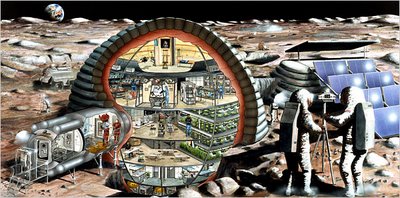
[Image: "The Alliance to Rescue Civilization differs from other so-called doomsday projects. It envisions a lunar base where, in the event of global catastrophe, humans could carry on, protecting DNA samples of life on Earth and maintaining a bank of human knowledge." They will all be avid readers of BLDGBLOG].
"What kind of feeble doomsday would leave London safe and sound?" the New York Times asked this morning. Indeed.
After all, any doomsday deserving of the word would surely destroy London – as well as every other city along with it. Perhaps even the whole planet.
Thankfully, then, there's the so-called Alliance to Rescue Civilization, or ARC. According to the New York Times, ARC is "a group that advocates a backup for humanity by way of a station on the Moon replete with DNA samples of all life on Earth, as well as a compendium of all human knowledge – the ultimate detached garage for a race of packrats. It would be run by people who, through fertility treatments and frozen human eggs and sperm, could serve as a new Adam and Eve in addition to their role as a new Noah."
It's interesting to read Biblical metaphors in the context of what amounts to science fiction, I have to say; at the very least, this raises the question of what officially banned Catholic heresies might once have existed – whose practitioners were all burnt at the stake for simply having reimagined the Bible as a kind of space opera written by Isaac Asimov. Emerging from the desert is a machine, full of light, called The Transubstantiator. Satanic anti-churches of dark matter spiral through magnetic voids...
In any case, the "mission" of the Alliance to Rescue Civilization is, in their own words, "to protect the human species and its civilization from destruction that could result from a global catastrophic event, including nuclear war, acts of terrorism, plague and asteroid collisions. To fulfill its mission, ARC is dedicated to creating continuously staffed facilities on the Moon and other locations away from Earth. These facilities will preserve backups of scientific and cultural achievements, and of the species important to our civilization. In the event of a global catastrophe, the ARC facilities will be prepared to reintroduce lost technology, art, history, crops, livestock and, if necessary, even human beings to the Earth."
The near impossibility of choosing exactly what "species [are] important to our civilization" is an issue for another day.
Finally, the idea of building a post-terrestrial earth surrogate that will save – or even mischievously re-direct – the human future is nothing new; a somewhat similar project, for instance, is Asteromo, Paolo Soleri's space-based drifting utopia, an artificial asteroid within which astral pilgrims will breed.
(Earlier: Lunar urbanism 6, Lunar urbanism 5, Lunar urbanism 4, Lunar urbanism 3 – and so on).
No comments:
Post a Comment